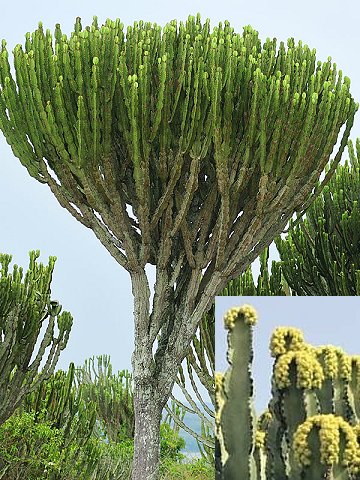
|
|
Candelabra tree
(Euphorbia ingens).
|
Candelabra tree - Euphorbia ingens
Euphorbia ingens is a species of flowering plant in the family Euphorbiaceae. It is native to dry areas of southern Africa. It is popularly known as the candelabra tree or naboom. Its milky latex can be extremely poisonous and is a dangerous irritant.
Candelabra trees are one of the world’s most striking organisms. Breathtaking to behold, these trees mark the African savanna with their yellow flowers and surreal shape.
Candelabra tree, the more colloquial or common name of Euphorbia ingens is found all over the world. This mysterious, yet strangely alluring tree was named
(botanical name Euphorbia) afterthe Greek Euphorbus physician of king Juba II of Numibia (52-50 BC - 23
AD), who discovered the plant in the Atlas mountains.
The name candelabra was given to Euphorbia ingens because they look like (obviously…) candelabras. Just admire the upward, clumped together branches of the tree. In addition, yellow flowers form on the tree’s ridges, completing a visual comparison to burning candles.
This tall fast growing succulent tree with green round-like branches resembling a balloon is 6–8 meters tall. Its trunk is thick. Candelabrum stems have 5 ridges each and are 3.5–7.5 centimeters thick. Segmented sprouts are dark-green. Young sprouts have paired spines 0.5–2 millimeters long, often reflected. Small greenish yellow flowers sit on the ridges of the topmost segment. The plant blooms from autumn to winter. A red, round, three-lobed capsule fruit turns purple when ripe.
The plant occurs in Malawi, Mozambique, Zimbabwe, Zambia, Botswana, Tanzania, South Africa (in the north and east of the country), Rwanda, Uganda, Kenya and Eswatini.
Candelabra trees can be found all over the world, from Africa to Mexico. The commonality is always hot and dry conditions. They simply thrive in areas where water is scarce and temperatures soar.
It grows on dry lands and semi-savannas. It prefers warm regions as it can survive long droughts. It usually roots on rocky outcrops or deep in sand among the bush.
True for all Candelabra trees is the fact that they cannot stand the cold. Anything below 10-12 degrees Celsius and you’ll not see the candelabra tree. However, it does survive indoors, especially in greenhouses or conservatories. So a candelabra is an ideal indoor addition for those who live in countries with a chilly climate.
The plant’s flowers are attractive for butterflies, bees and other insects, which pollinate them when gathering pollen and nectar.
Seeds are edible for birds, who also like to make their nests in the branches of these trees. Woodpeckers in particular often use withered segments for this purpose.
The candelabra tree not only has beautiful flowers, but will also bear fruit in optimum conditions. Monkeys are known to eat the fruit of the candelabra between August and November. However, the feasting from this tree doesn’t stop there.
Cane rats and porcupines sometimes eat the tree’s roots and there are some bird species who eat the seeds of the fruit. This is amazing since the candelabra tree actually has a defence mechanism that keeps many animals away. On the African savanna, candelabra trees produce a poisonous latex or sap and this largely keeps it free from browsers.
There are no recorded fatalities from ingesting the sap of the candelabra tree, but contact with the latex is known to cause a nasty skin irritation. When it gets in contact with your eyes it can cause blindness. In severe cases it can make the animal or human that ingests it very, very ill.
However, there is documented evidence that a candelabra tree kept two black rhinos alive in Liwonde National Park, Malawi. This happened during a severe drought in 1997. The rhinos could not drink as there was no water – so they fed from the tree and sucked out moisture from within the plant.
The milky latex of the tree is extremely poisonous and can cause blindness, severe skin irritation and poisoning (when ingested) in humans and animals. However, this plant has been used medicinally as a purgative or for ulcers. Venda and Sotho people of South Africa use it against cancer.
The Khoisan, a tribe native to the Western Cape of South Africa, named the candelabra tree “Gnap” which means powerful. They would tip the ends of their hunting spears into the sap in preparation for hunting.
In South Africa and Zimbabwe candelabra tree stems are also used to poison fish.Early fishermen used the poisonous sap to stun fish so they could then catch them by hand. A little poison in the water paralysed the fish so they didn’t need any other bait.
Light and solid, the wood is used in door, plank, and boat production.
Source:
https://en.wikipedia.org/wiki/Euphorbia_ingens
https://africafreak.com/candelabra-tree
